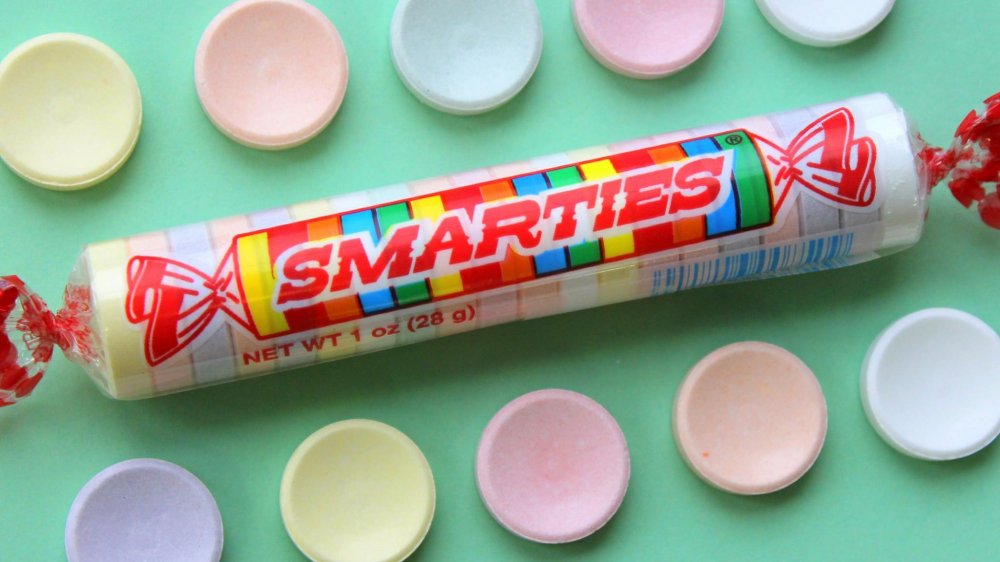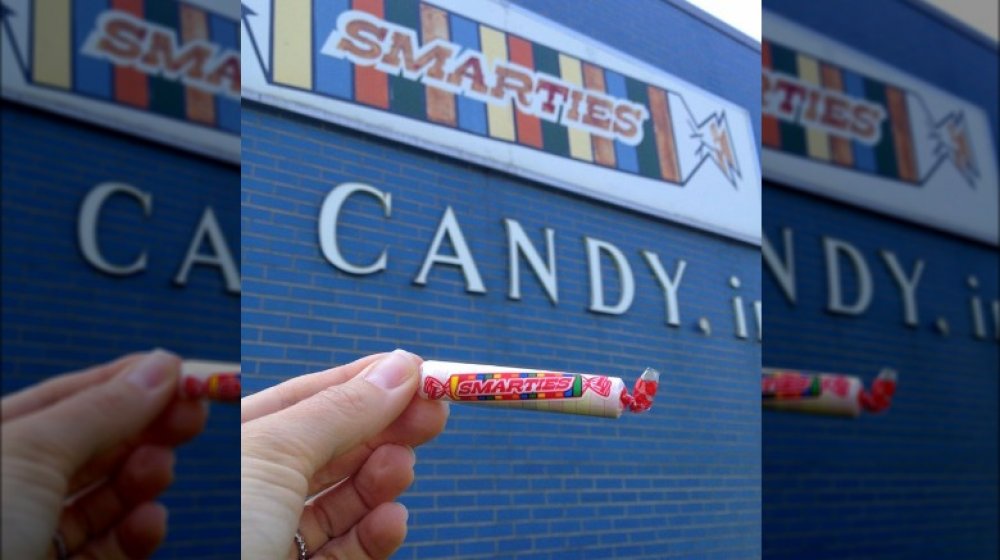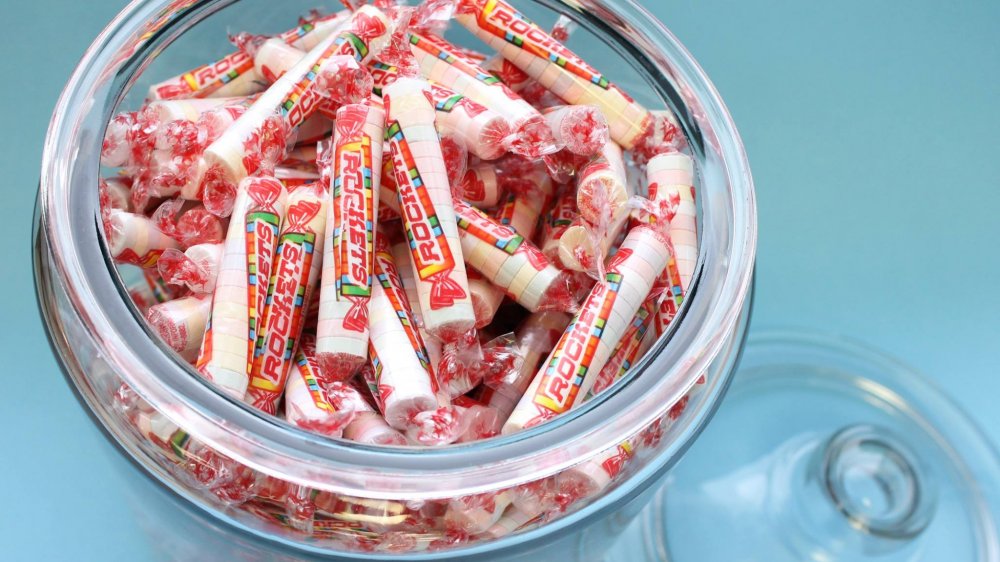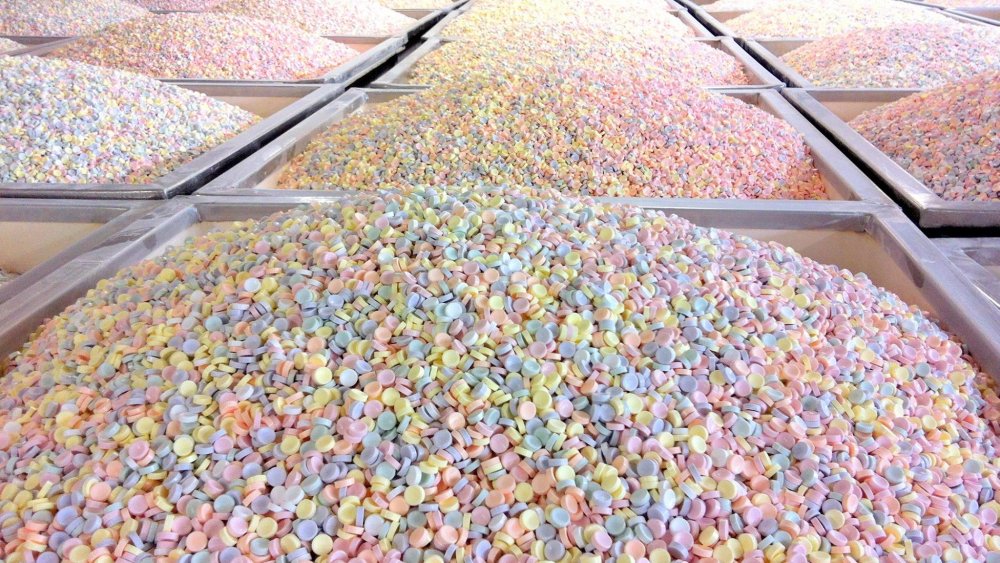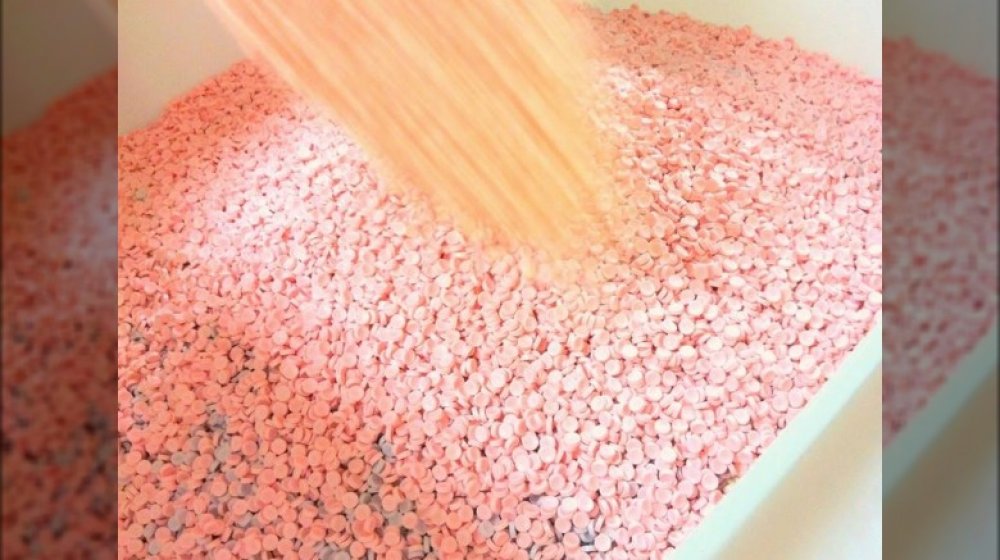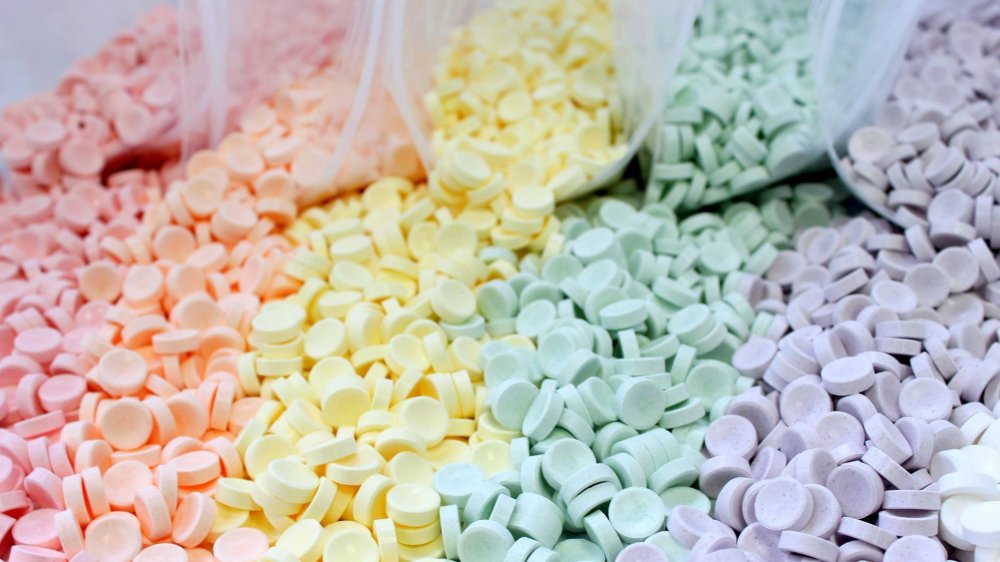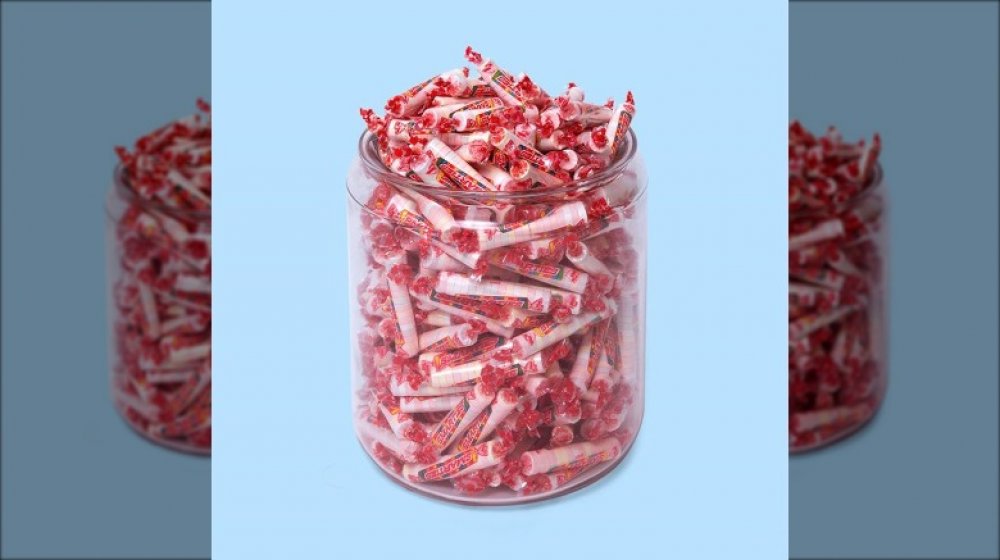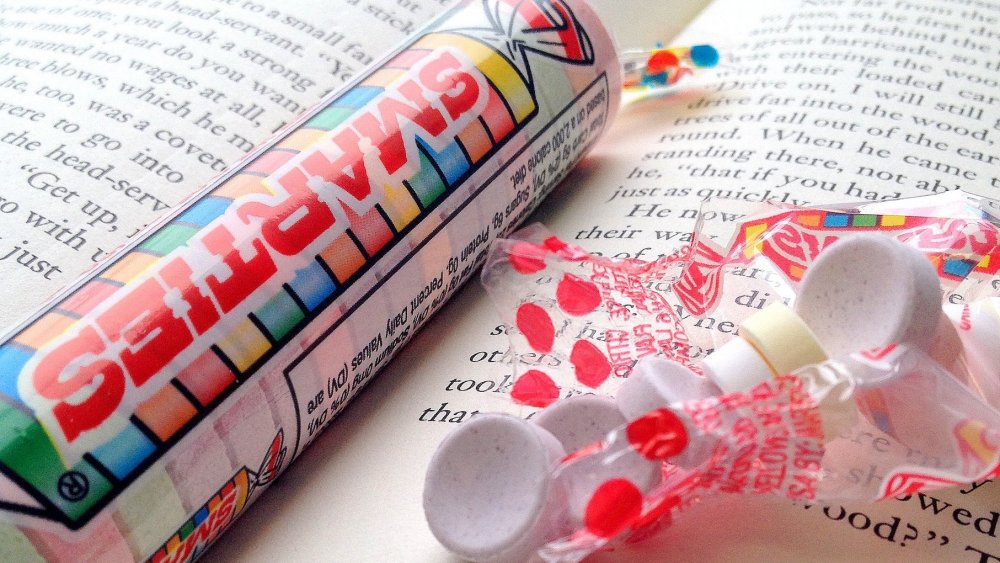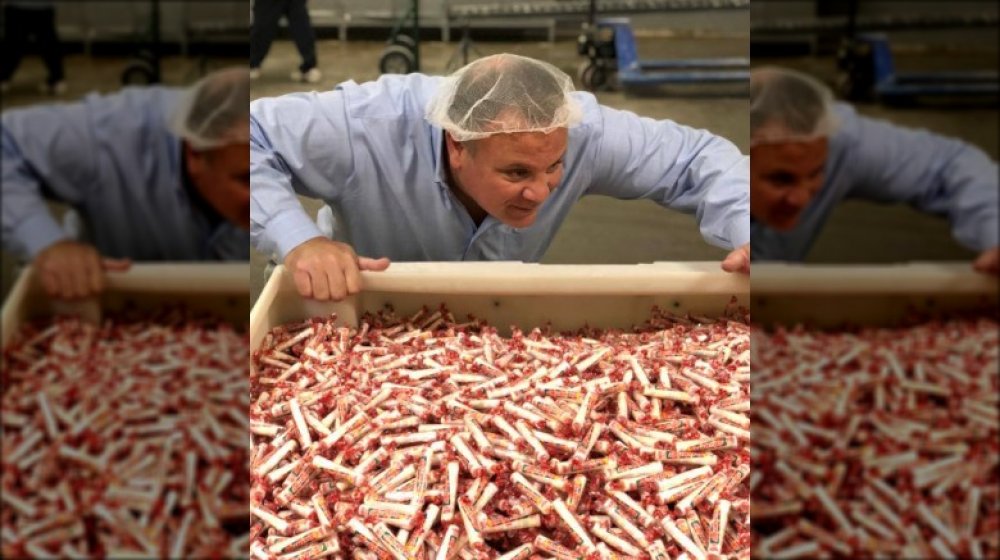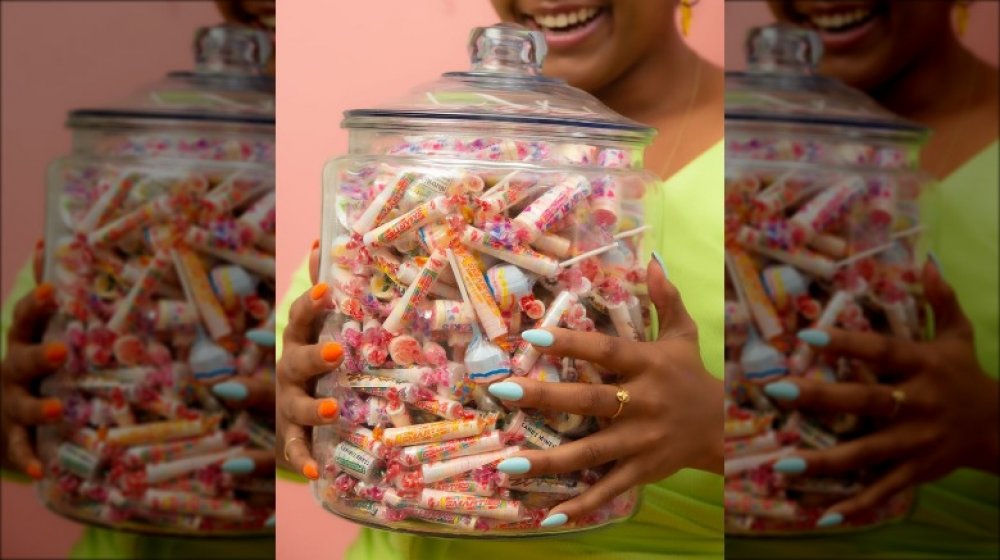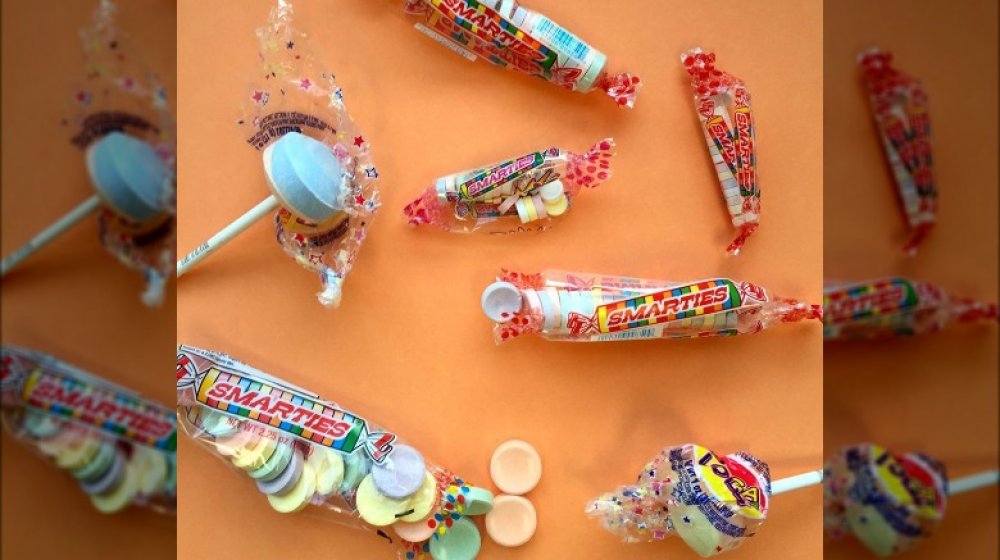The Untold Truth Of Smarties Candies
Smarties candies are one of the most recognizable, nostalgic candies out there, and they've been used for a lot of things over the years. We've seen them as prizes in a classroom, as tools for decorating a cake, as a simple addition to a kid's birthday party treat bag, and as the main (low cost) addition to your candy bowl on Halloween. The little pastel disks are seemingly everywhere, and they've been that way for a long time. Smarties Candy Company celebrated its 70th year operating in the United States in 2019, making it one of the longest-running family-run candy companies to continue producing a well-known product, according to CNBC.
But what is it that keeps those nostalgic little candy rolls so prevalent year after year? Surely, there must be a few secrets to keeping a candy company running for 70-plus years, right? We decided to take a look, diving deeper into those multi-colored candy tablets to find out more. This is the untold truth of Smarties candies.
It wasn't always called the Smarties Candy Company
The story of the iconic Smarties brand goes back decades to when Edward Dee moved with his family from England to New Jersey just a few years after World War II, bringing a revolutionary candy idea with him.
Edward Dee was already a third-generation candy maker in England, and it was in 1949, the same year he arrived in America, that Dee founded his own candy company in the United States. Naming it Ce De Candy Inc., they soon began making the Smarties candy we all know and love today.
According to Smarties, Edward Dee opened the first factory in a rented building in Bloomfield, New Jersey. He moved it to Elizabeth, New Jersey in 1959, and then again moved candy making operations to Union, New Jersey in 1967, where it has resided for decades. The company was producing Smarties the entire time, and in 2011 it was renamed to the Smarties Candy Company, as it's known today.
Smarties are called something different in Canada
Head to a local grocery store or drug store in the United States, and it's pretty easy to spot that iconic clear label with red print — once you spot it at a distance, you know without a doubt it's going to say "Smarties." But, purchasing the same product in Canada isn't quite the same. Upon first glance, the labels look identical, with the same shape and color palette, but if you look a bit closer, you'll notice a difference in names. They're not Smarties at all... but they are the same candy. In Canada, Smarties are known as Rockets.
Ce De Candy Company established production in Canada in 1963 with the founding of their Canadian branch, Ce De Candy Company Limited. They were making the same candy known to most people as Smarties, but calling them the same name would have caused confusion among the Canadian candy industry. Nestle had been producing their Smarties, a candy-coated chocolate treat since 1937, so Ce De Candy Company's version certainly could not be named Smarties, as well.
After years of being known as Rockets in Canada, Ce De Candy Company Limited changed its name to Rockets Candy Company in 2012 for easier association to their product — just one year after the American branch changed their name as well.
There's a ridiculous amount of Smarties made and sold
If you've taken a stroll through the candy aisle, well, pretty much ever, then you've probably seen Smarties candies. They may not be your favorite, but certainly, they have crossed your path at some point in time, and that can probably be said for millions of other people in North America.
As of 2019, Smarties Candy Company was producing over two billion Smarties rolls every year, according to CNBC. That adds up to around 30 billion tiny Smarties tablets. And to keep up with that impressive production number, Inc. says the equipment making Smarties needs to operate 24 hours a day for five days a week between the two factories.
Smarties Candy Company Co-president Lizz Dee explained to Reader's Digest that when the machines are running, the factories are producing 1,000 tablets per minute.
Halloween is Smarties Candy Company's biggest day
Halloween is a holiday dedicated to the ringing of doorbells and the collection of candy, and trick or treating is a huge tradition in many households. And to be prepared for all of those ghouls and goblins showing up at their doors, Americans buy a lot of candy. And we mean a lot. Americans buy close to 600 million pounds of candy for Halloween each year, equating to $2.75 billion spent on Halloween candy annually, and Smarties Candy Company has certainly been influenced by those numbers over the years.
"Oh, it's by far the most important holiday for us," Liz Dee, co-president of Smarties told Inc. And Smarties has to work ahead all year in order to meet demand.
According to Inc., the candy company's orders from retailers planning to stock Smarties for the holiday come in the prior November (so basically, immediately after Halloween they're ordering for next year), and candy making for those orders is underway throughout the spring and summer. Making sure their shipments are out on time for the big holiday results in a bit of a lull around Halloween, so much so that Smarties actually ends its fiscal year on Halloween.
Smarties Candy Company is run by three women
Since Edward Dee brought his family to the United States and started Smarties Candy Company, the company has been a family business. After Edward, his two sons Michael and Jonathan took over the family business, and then Dee's three granddaughters, all in their 30s as of 2019, took over as co-presidents.
The trio of two sisters and one cousin had been on different career paths, but they officially made their way back and took their titles from their fathers in 2017. Sarah Dee, Liz Dee, and Jessica Sawyer grew up in the Smarties factory, and they had all spent time there as children watching their grandfather and fathers build the candy company. "I spent some time out in the factory when I first started. So I drove a forklift which was really fun," Sarah Dee told Today.
And as the company has stayed in the family for three generations now, the three women absolutely intend to keep that family tradition going. As of 2020, none of the husbands of these three women works for the company, and as they plan to keep it that way, hoping their children will someday take over. Keeping it truly in the family is something they take seriously.
Smarties are made with only five ingredients
Looking at candy labels today, you'd be hard-pressed to find a candy option that only exists with five ingredients. But despite all of the additives found in other candy options, the ingredients list for Smarties is surprisingly pretty short.
According to Inc., Smarties started utilizing dextrose, a sugar derived from corn in the 1970s due to the rising costs of sugar, and they've continued to use it as their main ingredient since then.
To create Smarties, dextrose is combined with citric acid, used as a preservative and flavoring agent, along with calcium stearate (a caking agent) and natural and artificial flavors and colors.
Each roll of Smarties features six different flavors and corresponding colors including pineapple, orange, strawberry, grape, cherry, and orange cream. And with their minimal addition of ingredients, Smarties can boast that they're only 25 calories per roll as well.
The original Smarties machines were used for compressing gunpowder
Since Smarties candies date back to 1949, it's not hard to imagine that the equipment used for manufacturing candy at that time was certainly different than what's available today.
According to CBC, the original prototype for Smarties (or Rockets) wasn't invented in the U.S. The candy was first developed in England but was flavored using imported spices like cinnamon and clove. And they were developed utilizing old gunpowder pellet machines, repurposed for candy making after World War I. As it turns out, it was possible to make candy by compressing the Smarties ingredients the same way gunpowder was compressed.
"He came over with two machines in the beginning and what he was doing was pressing the tablets, which is actually how we still make the candy pieces today," co-president Liz Dee told Today. And although the company is a bit more advanced in its technology and methodology, that same concept of mixing and compressing ingredients is still used in producing Smarties in the factories today.
Smarties are not made using any liquid
When you think about a hard, pastel-like candy like Smarties you might assume there must be some sort of liquid incorporated into the process to form something like a dough. Sweethearts Conversation Hearts for example, similar in texture, utilize liquid in their mixture before being pressed into shape and dried. But Smarties are made with only dry ingredients.
Smarties combines its five ingredients, producing a dry mixture that's primed and ready for pressing. Each of the ingredients has to be ground just perfectly, with factors such as pressure, humidity, temperature, and static playing a role in the production, co-president, Liz Dee, told Reader's Digest. If the ingredients weren't prepared perfectly, the candy may not be strong enough to withstand all the jostling that comes with their production process. Passing through machine after machine, after all, can take a lot out of a tiny piece of candy.
The ingredients are combined and then they are all compressed by a punch and die machine into the shapes we all have come to recognize. Each of the six flavors are made individually with their separate coloring and flavoring, and once compressed they're put into buckets. Each of the buckets are eventually combined to mix the colors, before they head to different machines for packaging.
Smarties are vegan and gluten-free
With the major interest in the consumer market for gluten-free options, vegan options, and more, companies have been finding ways to offer more to their consumers. But Smarties didn't have to change their recipe to do that.
When it comes to gluten-free candy, each option needs to be free of grains like wheat, rye, and barley and many of the major candy options fall into that category such as Hershey's Milk Chocolate Bars, Reese's Peanut Butter Cups, Laffy Taffy, and Tootsie Rolls. But many of those options can't claim to be vegan as well, or allergen-free. With the small ingredients list that makes up Smarties, there's really not a whole lot to them, and that works in their favor.
According to Smarties, all of their products are indeed vegetarian and vegan, as well as gluten-free, and there's a specific UPC on their packages to assure those with Celiac that their products were made in a gluten-free facility, making them safe for consumption. In addition, the company boasts that its products are also peanut and tree nut-free (as well other top allergens), with measures to ensure that they are manufactured in a peanut-free facility as well.
Smarties treats their employees really well
Since we spend countless hours devoting our time to our jobs, it's important to love where you work. And certainly, there must be some sweet perks to working for such a long-running candy company, right? You bet. According to Inc., Smarties Candy Company employs approximately 100 people, and their Rockets factory in Canada employs about the same. And as the company aims to keep the feeling of the family business intact, they extend that family vibe to their employees.
The company prides itself on making flexible schedules a priority. "As a company, we pride ourselves on our family-friendly hours, encouraging us to spend more time with our families than a more traditional or corporate environment," Sarah Dee told HuffPost (via CNBC).
And although that's a great goal for a large candy company, there's something even sweeter the employees get. After a long year of prepping for Halloween candy sales, employees are each gifted 30 pounds of Smarties to help celebrate the holiday at parties with family and friends, or to give out to the trick or treaters visiting their house.
In addition, a company luncheon is hosted right around Halloween, celebrating the year they've had. Talk about a sweet way to celebrate those who have worked hard in the factory, producing candy all year long.
Smarties Candy Company is one of the few family-run candy companies around
Establishing a major candy company is no small feat. But continuing on that legacy and keeping it all in the family is an even larger accomplishment. According to PR Newswire, as of 2018, only 19 percent of the 28.8 million small businesses in the United States were actually family-owned. Furthermore, only 30 percent of family businesses can say they successfully survived the ownership transition from the first generation to the second generation, and only 12 percent survive from the second to the third.
But Smarties Candy Company, now successfully transitioned to its third-generation of ownership, can't say that those statistics affected them. And while that's an impressive accomplishment for any type of business, keeping the family ties going strong for so long, it's even more impressive in the world of candy.
According to CNBC, 65 percent of the U.S. candy market is made up of four public businesses, with Mars and Hershey holding the largest market share as of 2020. And with three cousins at the helm of the company now, all devoted to keeping it in the family, chances are, it will stay in the family for years to come.
The third generation has been innovative in moving Smarties forward
It's tricky for long-standing companies in the millennial age. While generations of consumers remember their candies for their recognizable wrappers, sometimes it's necessary to just switch things up a bit. Still, weighing nostalgia against innovation can be challenging.
The trio of Dee co-presidents have worked to make Smarties more present in the ever-changing world of social media, posting bright and colorful photos of their candies in different situations and showing off giant, and quite impressive, bins full of candy. But upping their social media game wasn't the only change the co-presidents have made.
According to CNN, they devoted efforts to making sure they had a faster candy press and quicker wrapper machine, allowing the company to produce 200 Smarties rolls per minute rather than the previous production at 125 a minute. But the changes still don't stop there since the company switched hands.
The Dees decided it was time for an aesthetic change for its 70th year in business, switching up the logo to something that was a bit brighter while still keeping with the same nostalgic and recognizable look consumers have come to love. According to Inc. the majority of consumers saw that new logo debut among Halloween 2019's candy supply.
The Smarties company makes and sells other products, too
Those cute little candy tablets are certainly what everyone thinks of when they hear Smarties in the U.S. or Rockets in Canada, and they have been Smarties Candy Company's best selling product since the very beginning. But the company started branching out to offer other similar products as well, diversifying their offerings. It's important to keep things fresh in order to stay relevant, right?
When Edward Dee's sons, Michael Dee and Jonathan Dee, took on leadership positions within the family candy company, they debuted a few new product lines along the way. During that time, X-treme Sour Smarties came along, in addition to Oversized Smarties and the ever-popular Candy Necklace.
But new products don't come without their challenges. In an interview with Inc., Liz Dee said that for every 10 new candy products the company successfully launches, only one is usually a lasting hit to keep on their main product line. That seems like a lot of wasted time and effort, but it's a necessary part of the business.
And they've added a few winners over the years, and so offer few products other than their original Smarties. The Giant Smarties are simply a jumbo version of the original Smarties, wrapped in a larger roll, and additional flavors of Smarties are now offered including a tropical version. Smarties also produces Smarties lollipops in a variety of flavors, and Smarties Candy Money, with imprints of dollar figures on each candy coin.
